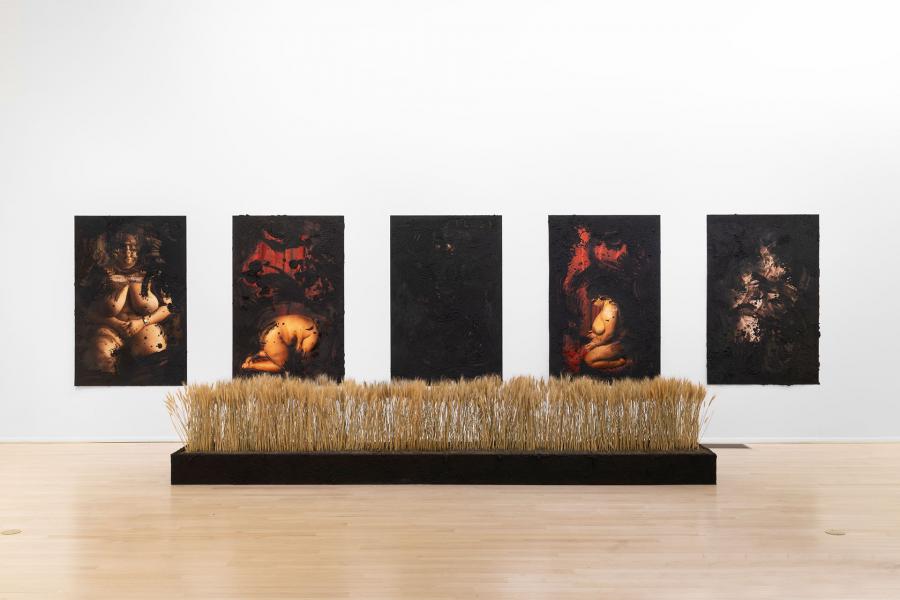Graduate | M.F.A. Program
MASTER OF FINE ARTS PROGRAM
Overview
Headed by an internationally distinguished faculty, the Graduate Program offers a rigorous, interdisciplinary environment for training in the visual arts. The three-year M.F.A. program comprises a series of core and elective classes in production, theory, and contemporary issues. Graduate students may also take advantage of the academic excellence UCI provides as a leading research university by taking courses in other departments and programs. Through a combination of faculty mentorship, seminars, and regular comprehensive peer critiques, the Department of Art affords an optimal intellectual setting for fostering creative and critical development. In addition to faculty dedicated to facilitating students' understanding of visual art and its cultural contexts, graduate students have access to visiting artists through lectures, studio visits, and colloquia.
Curriculum
The M.F.A. program is designed to provide a thorough and intensive professional training for students wishing to pursue careers in the field of contemporary art. The program emphasizes experimental and interdisciplinary approaches to art making, while also providing a solid grounding in various disciplinary mediums and post-studio practices. Students undergo a rigorous course of study combining seminar classes, intensive critique courses, and independent study.
During the first two years, students take courses from a curriculum, totaling 12 units each quarter. Beyond that, students can select additional course work from any sector of the department or university, including approved upper-division undergraduate courses. The third year is structured so that students can devote themselves to the production of their thesis exhibition, working intensively with a small faculty committee.
Students may design a course of study that does not focus solely on studio production. For example, students may concentrate course work outside the department in a research area or pursue a graduate emphasis (e.g., take courses in the Visual Studies PhD program or the Critical Theory Emphasis, both offered by the School of Humanities).
Every year, the department offers several lecture series, where artists, scholars, curators, critics, gallerists, and writers give lectures, engage in conversation, and conduct studio visits. These included the Graduate Colloquium (ART 220), the Visiting Artist Lecture Series (VALS), and the Catalyst Art Lecture Series (CALS). Organized by members of the faculty, the Colloquium invites speakers as part of a class where student engage in in-depth discussions in a rigorous academic setting, accompanied with supplementary readings and studio visits. Organized and run by a graduate student committee, VALS invites a slate of visiting artists and scholars relevant to graduate students' own research and practice to speak, often accompanied by studio visits. Organized by the undergraduate students, CALS coordinate noontime lectures of guests, often current M.F.A. students, to discuss their art practice, providing a mutually supportive link between the graduate and undergraduate student bodies. Together, these lecture series add to the dynamic exchange of ideas and scholarship that occurs inside and outside the classroom.
Exhibition Opportunities
Graduate students have opportunities to exhibit in the University Art Galleries. First-year and second-year M.F.A.s participate in Open Studios and mount exhibitions to evaluate students' progress towards the degree. Third-year M.F.A.s mount a thesis exhibition in the spring and mount a second exhibition outside campus in the summer after graduation.
Teaching Opportunities
Each graduate student is appointed to 6 Teaching Assistant and/or Teaching Associate positions during their three years in the program (two each year). Teaching Assistants are assigned to assist in the delivery of instruction under the tutelage and supervision of a faculty member. Some second- and third-year M.F.A.s are also appointed as Graduate Student Researchers, who are tasked with providing lab or office hours to assist students in accomplishing their work in the labs and class assignments. Some graduate students are appointed as Lecturers in the summer immediately following graduation from the program, while second-year M.F.A.s are appointed as T.A.s. These positions are all paid appointments.
Financial Packages and Fellowship Opportunities
Graduate financial packages are very competitive. Successful domestic applicants typically receive full academic financial support. Successful International applicants also typically receive very generous academic financial support for the first year and full academic support for the second and third years. The Department of Art is committed to providing as much funding as possible to assist all students in the completion of the degree. Students also take advantage of the numerous grant and fellowship opportunities available through the Claire Trevor School of the Arts, the University of California Institute for Research in the Arts, UCI Graduate Division, and other external agencies.
Facilities
Facilities include photography laboratories (analog and digital); digital filmmaking and video production studios; sculpture laboratories for work in wood, metal and ceramics; and Mechatronics laboratory to support work in art and technology. There are also facilities to support work in digital media, painting, drawing, performance, new media, and curatorial studies. For more information, please go to Facilities.
Studio Spaces
All M.F.A. candidates are provided with a studio space, either in the Contemporary Arts Center (single occupancy studios) or in the ACT Building (shared studios and single occupancy studios).
Location
UCI is located in the heart of Orange County and forty-five miles south of Los Angeles, where our faculty, students, and alumni are active participants in a rich and multi-layered art community.
















